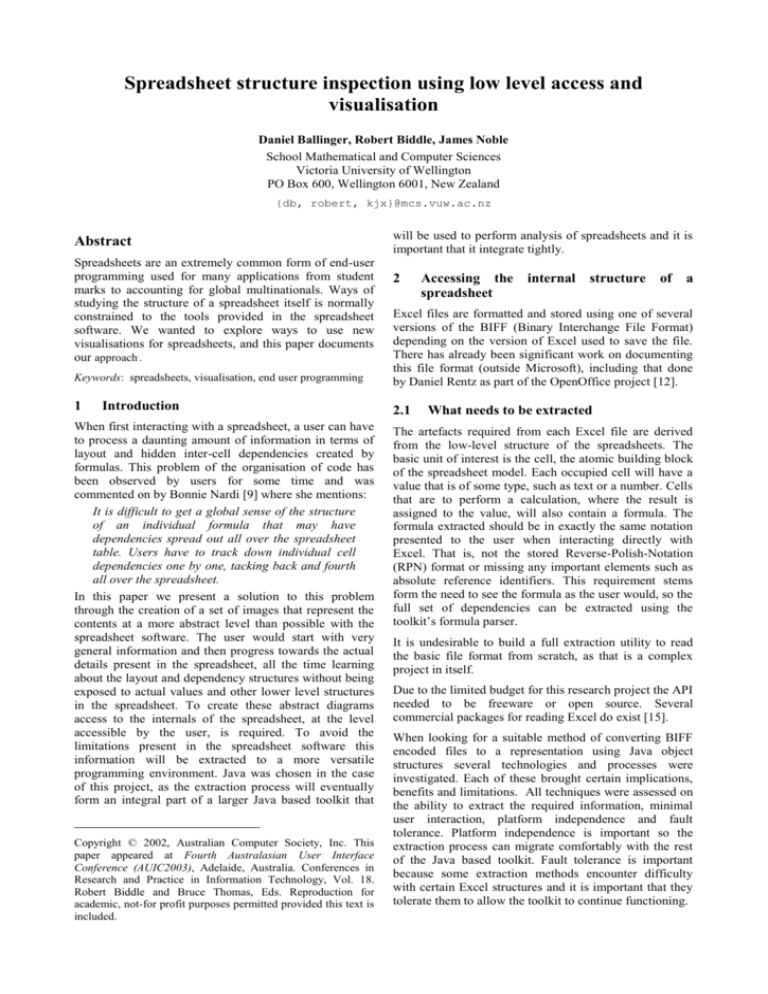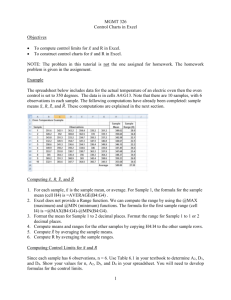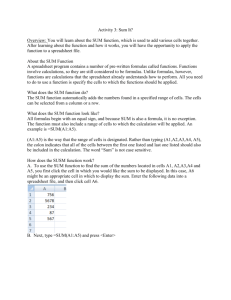auic-SSvis
advertisement

Spreadsheet structure inspection using low level access and
visualisation
Daniel Ballinger, Robert Biddle, James Noble
School Mathematical and Computer Sciences
Victoria University of Wellington
PO Box 600, Wellington 6001, New Zealand
{db, robert, kjx}@mcs.vuw.ac.nz
Abstract
Spreadsheets are an extremely common form of end-user
programming used for many applications from student
marks to accounting for global multinationals. Ways of
studying the structure of a spreadsheet itself is normally
constrained to the tools provided in the spreadsheet
software. We wanted to explore ways to use new
visualisations for spreadsheets, and this paper documents
our approach..
will be used to perform analysis of spreadsheets and it is
important that it integrate tightly.
2
Accessing the
spreadsheet
internal structure
of
a
Keywords: spreadsheets, visualisation, end user programming
Excel files are formatted and stored using one of several
versions of the BIFF (Binary Interchange File Format)
depending on the version of Excel used to save the file.
There has already been significant work on documenting
this file format (outside Microsoft), including that done
by Daniel Rentz as part of the OpenOffice project [12].
1
2.1
Introduction
When first interacting with a spreadsheet, a user can have
to process a daunting amount of information in terms of
layout and hidden inter-cell dependencies created by
formulas. This problem of the organisation of code has
been observed by users for some time and was
commented on by Bonnie Nardi [9] where she mentions:
It is difficult to get a global sense of the structure
of an individual formula that may have
dependencies spread out all over the spreadsheet
table. Users have to track down individual cell
dependencies one by one, tacking back and fourth
all over the spreadsheet.
In this paper we present a solution to this problem
through the creation of a set of images that represent the
contents at a more abstract level than possible with the
spreadsheet software. The user would start with very
general information and then progress towards the actual
details present in the spreadsheet, all the time learning
about the layout and dependency structures without being
exposed to actual values and other lower level structures
in the spreadsheet. To create these abstract diagrams
access to the internals of the spreadsheet, at the level
accessible by the user, is required. To avoid the
limitations present in the spreadsheet software this
information will be extracted to a more versatile
programming environment. Java was chosen in the case
of this project, as the extraction process will eventually
form an integral part of a larger Java based toolkit that
Copyright © 2002, Australian Computer Society, Inc. This
paper appeared at Fourth Australasian User Interface
Conference (AUIC2003), Adelaide, Australia. Conferences in
Research and Practice in Information Technology, Vol. 18.
Robert Biddle and Bruce Thomas, Eds. Reproduction for
academic, not-for profit purposes permitted provided this text is
included.
What needs to be extracted
The artefacts required from each Excel file are derived
from the low-level structure of the spreadsheets. The
basic unit of interest is the cell, the atomic building block
of the spreadsheet model. Each occupied cell will have a
value that is of some type, such as text or a number. Cells
that are to perform a calculation, where the result is
assigned to the value, will also contain a formula. The
formula extracted should be in exactly the same notation
presented to the user when interacting directly with
Excel. That is, not the stored Reverse-Polish-Notation
(RPN) format or missing any important elements such as
absolute reference identifiers. This requirement stems
form the need to see the formula as the user would, so the
full set of dependencies can be extracted using the
toolkit’s formula parser.
It is undesirable to build a full extraction utility to read
the basic file format from scratch, as that is a complex
project in itself.
Due to the limited budget for this research project the API
needed to be freeware or open source. Several
commercial packages for reading Excel do exist [15].
When looking for a suitable method of converting BIFF
encoded files to a representation using Java object
structures several technologies and processes were
investigated. Each of these brought certain implications,
benefits and limitations. All techniques were assessed on
the ability to extract the required information, minimal
user interaction, platform independence and fault
tolerance. Platform independence is important so the
extraction process can migrate comfortably with the rest
of the Java based toolkit. Fault tolerance is important
because some extraction methods encounter difficulty
with certain Excel structures and it is important that they
tolerate them to allow the toolkit to continue functioning.
The two third party libraries that follow provide the
toolkits current extraction abilities.
2.1.1
IBM alphaworks Java Bean
IBM alphaworks have produced the ExcelAccessor Java
bean suite [5] to access and modify the contents of
worksheets using a Windows DLL. This option was
trailed first as it had easy configuration options over the
other available methods. The bean usually works well,
but the use of native code and requirement of having
Excel installed limits its overall portability. Also, it is
prone to irregular crashes during larger processing jobs
involving multiple spreadsheets. When it does crash it
often leaves an Excel process open on Windows 9x with
subsequent runs having problems due to the still running
process.
In its favour is the ability to correctly extract the exact
components of the spreadsheet file that the user sees.
2.1.2
JExcelAPI
An alternative extraction process found uses JExcelApi
by Andy Khan [8]. Being pure Java it integrates well with
the rest of the toolkit and doesn’t require native code.
Some element types produce problems with the extraction
methods currently available, such as array functions,
intersections, absolute references that become relative in
formulas, and files using a BIFF from early versions of
Excel and the more recent XP version.
2.1.3
Future opportunities
The capability to extract values and string formulas in the
user observed format from all occupied cells of the
current range of freeware Java Excel readers is improving
constantly as most are still actively in development. An
example is the Apache POI project [10] where formula
support is still being added.
3
Aspects of Spreadsheet structure
The spreadsheet paradigm exhibits two main
characteristics: the spatial arrangement of cells on a table
and the logical relationships between them created by
formulas. These characteristics are not entirely disjoint,
with the spatial relationship between cells often having a
strong correspondence to the logical dependencies
between them. A third, temporal, characteristic is
exhibited by a subset of spreadsheets that are long-lived
and contain a large number of cells with complex
dependencies. Markus Clermont et al. observe that due to
the nature of these long lived sheets they can go through
similar evolutionary steps as conventional software [3].
programming [1]. Application domain experts are able to
express themselves in a reasonably transparent
programming environment in a similar fashion to how
they would with pen, paper, and a calculator. In doing
this, the developer is naturally attempting to organise the
arrangement of a sheet in a way related to its semantics
[3].
4
Software support for visualisation with
examples
The following figures are examples of images produced
by the toolkit. For the purposes of demonstrating how the
diagrams are derived from a single Excel workbook the
source spreadsheet has been specially constructed using 3
worksheets of hypothetical data and dependencies.
4.1
Real-estate utilisation
When first encountering an unfamiliar workbook it can be
useful to get a general orientating view of the layout of all
the worksheets.
By counting the number of occupied cells that occur at
each spreadsheet coordinate in each worksheet a realestate diagram is created. The main purpose of this
diagram is to understand basic positioning information
about the workbook. Using this diagram it is possible to
quickly get an impression about which sections of the
spreadsheet are occupied and to what extent these
sections are utilised. This diagram also makes finding
sections of data that the designer has purposely tried to
obscure easier to find. These obscured sections will often
be dragged to a far corner of the sheet and provide
functionality that does not need to be seen when using the
core of the sheet, such as lookup tables.
In the following diagrams, the cells in the spreadsheet are
arranged on the grid lines in their corresponding spatial
positions. This produces a diagram with a layout very
similar to that presented in Excel. The advantage of this is
that relationships understood in one view could more
easily be carried over to the view presented in Excel.
Two alternative methods are available to display this
information.
Studies have investigated how spreadsheets assist
usability.
The benefit of the spreadsheet paradigm is that it allows
users to represent their understanding of the problem
space on a two-dimensional table. This visual tabular
layout is augmented via invisible formulas [6]. While
entering raw data and formulas into the spreadsheet, users
are shielded from the low-level details of traditional
Figure 1. Real-estate utilisation diagram in 2D
The first approach makes use of Java’s standard graphics
environment to draw grid-based 2D data as in Figure 1.
In this diagram the number of cells that occur at each grid
coordinate are counted and displayed using a heat map
colour. Grid coordinates where a large number of cells
occur will be coloured towards the red end of the colour
spectrum will those with lower counts will be coloured
towards the violet/blue end. Each row and column in this
figure has a 1 to 1 relationship with the rows and columns
in the spreadsheet respectively.
Figure 3 shows the first sheet in the example workbook
with precedent trace arrows added by Excel’s built in
auditing tools. We have added boxes by hand containing
the formula present in the space immediately to the right
of each cell. This particular sheet shows the 4 main
techniques that a user can embed in a formula to
reference other cells. Notice how Excel’s trace is
somewhat deceptive in the case of an intersection, in this
case looking more like an individual cell reference.
Figure 4. Formula Extracted from Sheet 1
Figure 2. Real-estate utilisation diagram in 3D
The second real-estate diagram utilises a 3D surface map
approach created using Java3D [7] and VisAD [4], a
visualisation tool for numerical data. This has the benefit
of being interactive by allowing the user to rotate and
zoom the image. An example of this type of diagram is
Figure 2. In this figure the left axis contains the rows and
the upper (obscured) axis the columns. The altitude
represents the occupancy level and is coloured to create a
terrain type appearance.
4.2
Formulas at a Sheet Level
Once the user understands which parts of the spreadsheet
are occupied the formulas that occupy each sheet can be
examined.
4.2.1
In Figure 4, created by the toolkit, a precedent cell
dependency is represented by a blue arrow in a similar
fashion to that present in Excel. Each cell containing a
formula has a circle that represents the length of the
formula as a string and hence the intersection has a larger
circle than the union. Any ranged references are shown
using a shaded box. A single range is shaded light grey
while a union has the left and right sub-ranges coloured
blue and green respectively. Intersections use yellow and
red boxes for the left and right sub-ranges. The actual
resulting intersection is shaded dark blue.
4.2.2
Absolute and relative references
Referencing cells
Each dependency created by logical references between
cells in formulas can be converted to a mathematical
vector. The vector between cells has an origin set at the
referencing cell and a magnitude that ends the vector to
the referenced cell.
Figure 5. Sheet 2 with precedents trace
Figure 6. Formula Extracted from Sheet 2
Figure 5 and 6 demonstrate the colouring of relative and
absolute cell references. The reference from B1, coloured
blue, is a standard relative reference. B3 has a red
absolute reference. A2 and C2 are both partially absolute
Figure 3. Sheet 1 with a precedents trace
references, in that only one axis is fixed with the $
symbol, and are coloured yellow and green respectively.
The distinctive colouring of these different styles of
referencing should help in identifying patterns on large
more complex sheets.
4.2.3
A more realistic Summation example
5
Conclusions
This paper details the creation of a tool to first extract
artefacts from spreadsheets and then convert this basic
information into visualisations. Its purpose is to augment
that provided already by Excel and make it easier to then
create new diagrams.
The extraction methods and basic visualisations presented
in this paper are encompassed in a larger suit of tools
intended to be used for corpus based visualisations.
References
[1] YIRSAW AYALEW, MARKUS CLERMONT, ROLAND
T. MITTERMEIR. (2000): Detecting Errors in Spreadsheets.
Figure 7. Sheet 4 with precedents trace
[2] M. BURNETT, A. SHERETOV, B. REN, G.
ROTHERMEL. (2002): Testing Homogeneous Spreadsheet
Grids with the 'What You See Is What You Test'
Methodology, IEEE Trans. Software Engineering.
[3] MARKUS CLERMONT, CHRISTIAN HANIN, ROLAND
MITTERMEIR. (2002): A Spreadsheet Auditing Tool
Evaluated in an Industrial Context.
http://www.sysmod.com/eusprig02.htm
[4] BILL HIBBARD. VisAD, Java component library, Space
Science and Engineering Center - University of
Wisconsin - Madison.
http://www.ssec.wisc.edu/~billh/visad.html
[5] IBM alphaWorks (1999): ExcelAccessor bean suite.
http://www.alphaworks.ibm.com/ab.nsf/bean/ExcelAccessor
Figure 8. Formula Extracted from Sheet 4
Figure 7 and 10 demonstrate a more realistic style of
worksheet where a series of columns are summed and
then crosschecked with the sum of the rows. This style of
image is similar to the static global view in [6].
4.3
Related Work
The Holy Grail in spreadsheet research at the moment
appears to be the admirable goal of detecting and
correcting errors [1, 2, 3, 6, 9, 11].
Margaret Burnett is continuing the development of a
visual testing methodology to complement the visual
programming environment that spreadsheets use [2]. The
motivation for this comes from the high degree of errors
that are often present in spreadsheets.
Takeo Igarashi presented a series of techniques to address
the hidden dataflow graphs and superficial tabular layouts
of spreadsheets in [6]. They were designed to improve the
users understanding of the dataflow structure by enabling
them to visually interact with the obscured structures. He
mentions that there is a need to integrate these diagrams
into a more realistic spreadsheet program. We have
addressed this by allowing the diagrams to be generated
free from the application.
Jorma Sajaniemi has presented a theoretical model of
spreadsheets along with a description of various
spreadsheet auditing mechanisms employing the model
[13]. Our toolkit could be used to support such
mechanisms.
[6] TAKEO IGARASHI, JOCK MACKINLAY, BAY-WEI
CHANG, POLLE ZELLWEGER. (1998): Fluid Visualization
of
Spreadsheet
Structures,
IEEE.
http://www.parc.xerox.com/pollez/papers/fluid-spread-vl98.pdf
[7]
Java
3D™
API,
Sun
Microsystems,
Inc.
http://java.sun.com/products/java-media/3D/
[8] ANDY KHAN. JExcelAPI - A Java API to read Excel 97
spreadsheets.
http://www.andykhan.com/excelread/index.html
[9] BONNIE A. NARDI. (1993): A Small Matter of
Programming: Perspectives on End User Computing, MIT
Press.
[10] ANDREW C. OLIVER, NICOLA KEN BAROZZI.
(2002): HSSF (Horrible Spreadsheet Format) part of POI,
Apache Software Foundation.
http://jakarta.apache.org/poi/hssf/index.html
[11] RAYMOND D. PANKO. (1998): What We Know About
Spreadsheet Errors, Journal of End User Computing.
[12]
DANIEL
RENTZ.
(2002):
OpenOffice.org's
Documentation of the Microsoft® Excel File Format,
OpenOffice.org.
http://sc.openoffice.org/
[13] JORMA SAJANIEMI. (1998): Modeling Spreadsheet
Audit: A Rigorous Approach to Automatic Visualization,
Journal of Visual Languages and Computing.
[14] TONY SINTES. (2001): It's Excel-lent - Read MS Excel
files with Java, JavaWorld.
http://www.javaworld.com/javaworld/javaqa/2001-06/04-qa-0629excel.html
[15] ACTUATE (2002): Formula One e.Spreadsheet Engine.
http://www.actuate.com/f1/products/espreadengine.asp





